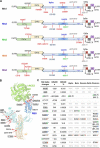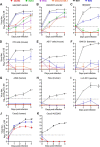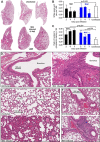Evolution of ACE2-independent SARS-CoV-2 infection and mouse adaption after passage in cells expressing human and mouse ACE2
- PMID: 35919871
- PMCID: PMC9338707
- DOI: 10.1093/ve/veac063
Evolution of ACE2-independent SARS-CoV-2 infection and mouse adaption after passage in cells expressing human and mouse ACE2
Abstract
Human ACE2 Human angiotensin converting enzyme 2 (hACE2) is the key cell attachment and entry receptor for severe acute respiratory syndrome coronavirus 2 (SARS-CoV-2), with the original SARS-CoV-2 isolates unable to use mouse ACE2 (mACE2). Herein we describe the emergence of a SARS-CoV-2 strain capable of ACE2-independent infection and the evolution of mouse-adapted (MA) SARS-CoV-2 by in vitro serial passaging of virus in co-cultures of cell lines expressing hACE2 and mACE2. MA viruses evolved with up to five amino acid changes in the spike protein, all of which have been seen in human isolates. MA viruses replicated to high titers in C57BL/6J mouse lungs and nasal turbinates and caused characteristic lung histopathology. One MA virus also evolved to replicate efficiently in several ACE2-negative cell lines across several species, including clustered regularly interspaced short palindromic repeats/CRISPR-associated protein 9 (CRISPR/Cas9) ACE2 knockout cells. An E484D substitution is likely involved in ACE2-independent entry and has appeared in only ≈0.003 per cent of human isolates globally, suggesting that it provided no significant selection advantage in humans. ACE2-independent entry reveals a SARS-CoV-2 infection mechanism that has potential implications for disease pathogenesis, evolution, tropism, and perhaps also intervention development.
Keywords: ACE2-independent infection; COVID-19; SARS-CoV-2; mouse adaptation.
© The Author(s) 2022. Published by Oxford University Press.
Figures







Similar articles
-
TMEM106B-mediated SARS-CoV-2 infection allows for robust ACE2-independent infection in vitro but not in vivo.Cell Rep. 2024 Nov 26;43(11):114921. doi: 10.1016/j.celrep.2024.114921. Epub 2024 Oct 31. Cell Rep. 2024. PMID: 39480813
-
SARS-CoV-2 Causes Lung Infection without Severe Disease in Human ACE2 Knock-In Mice.J Virol. 2022 Jan 12;96(1):e0151121. doi: 10.1128/JVI.01511-21. Epub 2021 Oct 20. J Virol. 2022. PMID: 34668780 Free PMC article.
-
Mouse-Adapted SARS-CoV-2 MA10 Strain Displays Differential Pulmonary Tropism and Accelerated Viral Replication, Neurodissemination, and Pulmonary Host Responses in K18-hACE2 Mice.mSphere. 2023 Feb 21;8(1):e0055822. doi: 10.1128/msphere.00558-22. Epub 2023 Feb 2. mSphere. 2023. PMID: 36728430 Free PMC article.
-
ACE2-Independent Alternative Receptors for SARS-CoV-2.Viruses. 2022 Nov 16;14(11):2535. doi: 10.3390/v14112535. Viruses. 2022. PMID: 36423144 Free PMC article. Review.
-
The expression of hACE2 receptor protein and its involvement in SARS-CoV-2 entry, pathogenesis, and its application as potential therapeutic target.Tumour Biol. 2021;43(1):177-196. doi: 10.3233/TUB-200084. Tumour Biol. 2021. PMID: 34420993 Review.
Cited by
-
SARS-CoV-2 omicron BA.5 and XBB variants have increased neurotropic potential over BA.1 in K18-hACE2 mice and human brain organoids.Front Microbiol. 2023 Nov 23;14:1320856. doi: 10.3389/fmicb.2023.1320856. eCollection 2023. Front Microbiol. 2023. PMID: 38075874 Free PMC article.
-
The effects of iron deficient and high iron diets on SARS-CoV-2 lung infection and disease.Front Microbiol. 2024 Sep 4;15:1441495. doi: 10.3389/fmicb.2024.1441495. eCollection 2024. Front Microbiol. 2024. PMID: 39296289 Free PMC article.
-
Mouse models of COVID-19 recapitulate inflammatory pathways rather than gene expression.PLoS Pathog. 2022 Sep 26;18(9):e1010867. doi: 10.1371/journal.ppat.1010867. eCollection 2022 Sep. PLoS Pathog. 2022. PMID: 36155667 Free PMC article.
-
Harnessing defective interfering particles and lipid nanoparticles for effective delivery of an anti-dengue virus RNA therapy.Mol Ther Nucleic Acids. 2024 Dec 12;36(1):102424. doi: 10.1016/j.omtn.2024.102424. eCollection 2025 Mar 11. Mol Ther Nucleic Acids. 2024. PMID: 39817192 Free PMC article.
-
Virus-like particle vaccine with authentic quaternary epitopes protects against Zika virus-induced viremia and testicular damage.J Virol. 2025 Apr 15;99(4):e0232224. doi: 10.1128/jvi.02322-24. Epub 2025 Feb 27. J Virol. 2025. PMID: 40013767 Free PMC article.
References
-
- Andrews S. (2010) ‘A Quality Control Tool for High Throughput Sequence Data’. https://www.bioinformatics.babraham.ac.uk/projects/fastqc/, accessed 21 July 2022.
LinkOut - more resources
Full Text Sources
Molecular Biology Databases
Miscellaneous

